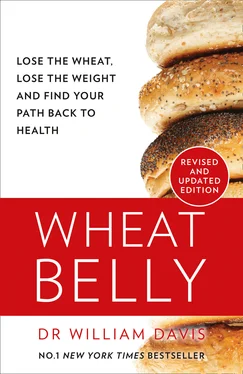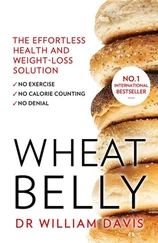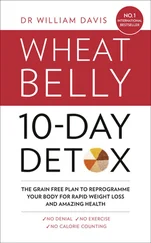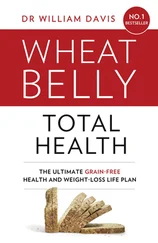In other words, in the human body, all fat is not equal. Wheat belly fat is an especially bad fat. The belly is not just a passive repository for excess pizza calories; it is, in effect, an endocrine gland much like your thyroid gland or pancreas, albeit a very large and active endocrine gland. (Ironically, Grandma was correct forty years ago when she labeled an overweight person as having a “gland” problem.) Unlike other endocrine glands, the visceral fat endocrine gland does not play by the rules, but it follows a unique playbook that works against the body’s health.
So a wheat belly is not just unsightly, it’s also dreadfully unhealthy.
GETTING HIGH ON INSULIN
Why is wheat so much worse for weight than other foods?
The essential phenomenon that sets the growth of the wheat belly in motion is high blood sugar (glucose). High blood sugar, in turn, provokes high blood insulin. (Insulin is released by the pancreas in response to the blood sugar: The higher the blood sugar, the more insulin must be released to move the sugar into the body’s cells, such as those of muscle, liver, and fat cells.) When the pancreas’s ability to produce insulin in response to blood sugar rises is exceeded, diabetes develops. But you don’t have to be diabetic to experience high blood sugar and high insulin: Non-diabetics can easily experience the high blood sugars required to cultivate their very own wheat belly, particularly because foods made from wheat so readily convert to sugar.
High blood insulin provokes visceral fat accumulation, the body’s means of storing excess energy. When visceral fat accumulates, the flood of inflammatory signals it produces causes tissues such as muscle and liver to respond less to insulin. This so-called insulin resistance means that the pancreas must produce greater and greater quantities of insulin to metabolize the sugars. Eventually, a vicious cycle of increased insulin resistance, increased insulin production, increased deposition of visceral fat, increased insulin resistance, etc., etc., ensues.
Nutritionists established the fact that wheat increases blood sugar more profoundly than table sugar forty years ago. As we’ve discussed, the glycemic index, or GI, is the nutritionist’s measure of how much blood sugar levels increase in the 90 to 120 minutes after a food is consumed. Whole wheat bread has a GI of 72, while plain table sugar has a GI of 59 (though some labs have gotten results as high as 65). In contrast, kidney beans have a GI of 51, grapefruit comes in at 25, while non-carbohydrate foods such as salmon, eggs, and walnuts have GIs of zero: Eating these foods has no effect on blood sugar. In fact, with few exceptions, few foods have as high a GI as foods made from wheat. Outside of dried fruits such as dates and figs, the only other foods that have GIs as high as wheat products are dried, pulverized starches such as cornstarch, rice starch, potato starch, and tapioca starch. (It is worth noting that these are the very same carbohydrates used to make “gluten-free” foods. More on this peculiar and maddening situation later.)
Because wheat and grain carbohydrate, the uniquely digestible amylopectin A, causes a greater spike in blood sugar than virtually any other food—more than a candy bar, table sugar, or ice cream—it also triggers greater insulin release. More amylopectin A means higher blood sugar, higher insulin, more visceral fat deposition … bigger wheat belly. Or rye belly, barley belly, corn belly, and oat belly.
Throw in the inevitable drop in blood sugar (hypoglycemia) that is the natural aftermath of high insulin levels, and you see why irresistible hunger so often results, as the body tries to protect you from the dangers of low blood sugar. You scramble for something to eat to increase blood sugar, and the cycle is set in motion again, repeating every two hours.
Factor in your brain’s response to the euphoric exorphin effects induced by wheat (and the potential for withdrawal if your next “fix” is missed), and it’s no wonder the wheat belly encircling your waist continues to grow and grow.
MEN’S LINGERIE IS ON THE SECOND FLOOR
Wheat belly is not just a cosmetic issue, but a phenomenon with real health consequences. In addition to producing inflammatory hormones such as leptin, visceral fat is also a factory for estrogen production in both sexes, the very same estrogen that confers female characteristics on girls beginning at puberty, such as widening of the hips and growth of the breasts. Estrogen levels are oddly jacked up by visceral fat of the wheat belly and peculiar and unwanted effects in both women and men follow.
Until menopause, adult females have high levels of estrogen. Surplus estrogen, however, produced by visceral fat adds considerably to breast cancer risk, since estrogen at high levels stimulates breast tissue. 11Thus, increased visceral fat on females has been associated with as much as fourfold increased risk for breast cancer. Breast cancer risk in postmenopausal women with the visceral fat of a wheat belly is double that of slender, non-wheat-belly-bearing postmenopausal females. 12Despite the apparent connection, no study—incredibly—has examined the results of a wheat-free, lose-the-visceral-fat-wheat-belly diet and its effect on the incidence of breast cancer. If we simply connect the dots, a marked reduction in risk would be predicted.
Males, having only a tiny fraction of the estrogen of females, are sensitive to anything that increases estrogen. The bigger the wheat belly in males, the more testosterone is converted to estrogen by visceral fat tissue via the aromatase enzyme. Since estrogen stimulates growth of breast tissue, elevated estrogen levels can cause men to develop larger breasts—those dreaded “man boobs,” “man cans,” or, for you professional types, gynecomastia. 13Levels of the hormone prolactin are also increased substantially by visceral fat. 14As the name suggests (prolactin means “stimulating lactation”), high prolactin levels stimulate breast tissue growth and milk production. To make matters worse, one of the exorphin breakdown products of wheat gliadin, called the B 5pentapeptide, is another potent stimulator of the pituitary gland’s release of prolactin in males. 15
Enlarged breasts on a male are therefore not just the embarrassing body feature that your annoying nephew snickers at, but B-cup evidence that estrogen and prolactin levels are increased due to the inflammatory and hormonal factory hanging around your waist, as well as peculiar digestive by-products of gliadin that make your body do things it should not.
An entire industry has emerged to help men embarrassed by their enlarged breasts. Male breast reduction surgery is booming, growing nationwide at double-digit rates. Other “solutions” include special clothing, compression vests, and exercise programs. (Maybe Seinfeld ’s Kramer wasn’t so crazy when he invented the mansierre.)
Increased estrogen, breast cancer, man boobs … all from the bag of bagels shared at the office.
CELIAC DISEASE: A WEIGHT LOSS LABORATORY
As noted earlier, the one ailment to which wheat has been conclusively linked even among conventional dietary thinkers is celiac disease. Celiac sufferers are counseled to remove wheat products and other gluten-containing grains from their diet, lest all manner of nasty complications of their disease develop. What can their experience teach us about the effects of wheat elimination? In fact, there are unclaimed gems of important weight loss lessons to be gleaned from clinical studies of people with celiac disease who remove wheat gluten–containing foods.
The lack of appreciation of celiac disease among physicians, coupled with its many unusual presentations (for example, fatigue or migraine headaches without intestinal symptoms), means an average delay of eleven years from symptom onset to diagnosis. 16, 17Some celiac sufferers therefore develop a severely malnourished state due to impaired nutrient absorption at the time of diagnosis. This is especially true for children with celiac disease, who are often both underweight and underdeveloped for their age. 18
Читать дальше












